It’s a Friday night in August in Grand Forks, N.D., and the traveling World of Outlaws NOS Energy Drink Sprint Car Series has the crowd in a lather at River Cities Speedway.
Even the mosquitoes, seemingly the size of hummingbirds, cannot put a damper on another standing-room-only crowd at the track that has been billed the world’s “baddest bullring.”
Thousands more will witness another side-by-side, hold-your-breath-in-traffic, mud-slinging, nerf-bar-to-nerf-bar battle on pay-per-view.
Mark Dobmeier is the undisputed local favorite, and though he’s defeated the Outlaws at other tracks, he’s never won one here.
“We were able to run all the way up to second that night,” he remembered. “The electricity in the place was unreal. I think we made a two-car pass to get up to second and you could literally feel the crowd in the air. Even the Outlaws officials said it was the first time they ever had the crowd cheering louder for the second-place finisher than the winner. Everyone was going nuts over the volume and the sheer electricity of that night.”
River Cities is a banked three-tenths-mile oval that is home to sub-10-second laps for sprint cars (Jason Meyers set the track record at 9.269 seconds in 2009), door-to-door late model wars and is the Friday night hangout for race fans in eastern North Dakota.
Weekly shows at River Cities are a race fan’s dream, featuring Northern Outlaw Sprint Ass’n sprint cars, NLRA late models, WISSOTA Midwest modifieds, street stocks and NLSA sprint cars.
Three-time NLRA champion Brad Seng relates a funny story regarding the on-track excitement.
“I remember when Lance Mathies made his first couple of trips up here,” Seng said. “He had made the redraw and had the microphone stuck in his mouth. When asked what he thought of the place, he said, ‘S— happens fast.’ That pretty much sums it up.”
Racing runs deep in Grand Forks. In fact, the city itself was founded in part due to racing. In the late fall of 1870, a flatboat race occurred between eventual Grand Forks Herald founder George Winship and the team of Alexander Griggs. Winship won and Griggs spent the winter in the area, founding the city of Grand Forks.
The first formal racing organization was formed in 1882. The Grand Forks Racing Ass’n was created to “promote good sportsmanship on the turf.” The race track was located west of town at Eshelman Park (the present site of the University of North Dakota’s Memorial Stadium).
Racing and the college became popular activities. Seng can relate, “My friends were into (racing), and I was young. They were racing and it was a Friday night. Nothing really goes on here in Grand Forks. We have (UND) Fighting Hawk hockey in the winter and racing in the summer. For whatever reason, I’m still hooked. I grew up watching short-track racing here, so I really didn’t know more than a quarter mile. I grew up watching the sprint cars all my life, and they’re pretty damn exciting to be honest. Every other class is too, from the streeters to the B-Mods to the late models. You never see a bad race on this track.”
The track was shared by the Trotting Ass’n, the Driving Club and the Polo Club. The races became popular for locals in the summer. but the university president had doubts about the appropriateness of racing activities so close to campus. His fear was that students would be influenced by the gambling accompanying the horse racing.
Eshelman Park hosted the first fair in Grand Forks in 1886. The infield of the half-mile race track was used for exhibit buildings, vendors and gaming. More than 11,000 people attended the fair. The next two years saw Grand Forks hosting the official Territorial Fairs and it became home to the early North Dakota State Fairs
Land was purchased from the D.A. Dinnie Farm for the current Grand Forks County Fairgrounds in 1903. Horse races and a two-mile automobile race were attractions offered by the 1903 Red River Valley Exposition. Through the years, motorcycles and cars replaced horses on the half-mile race track.
Click below to keep reading.
